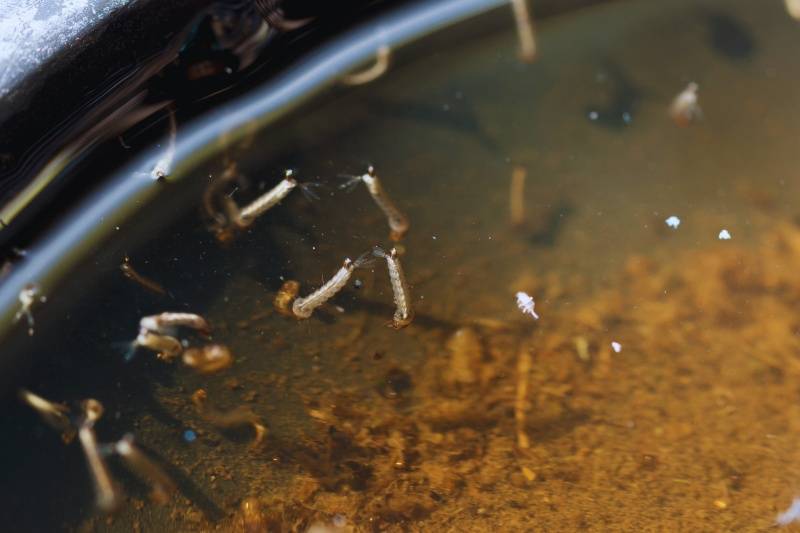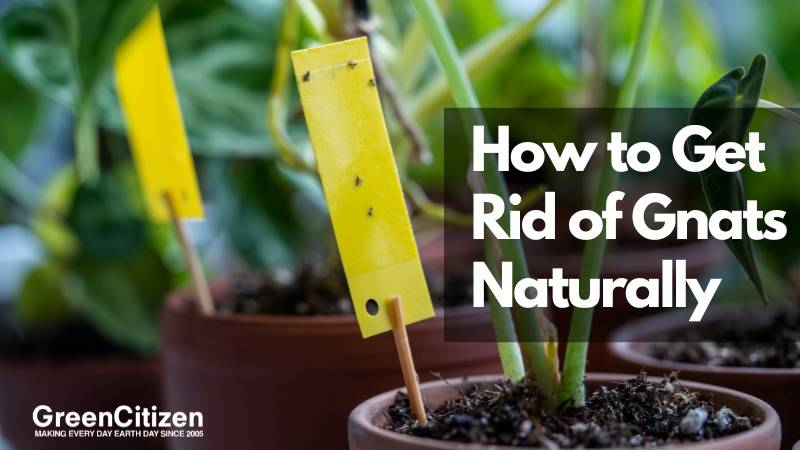Gnats can be a real nightmare for gardens. These tiny pests can attack any decaying organic matter, causing damage and frustration. In no time, they can infest your entire home.
Did you know that a female gnat can lay up to 500 eggs in her lifetime? They lay about 30 at a time on rotting organic matter.
This rapid reproduction makes them a significant problem.
I once left a bunch of bananas on the counter, and within days, my kitchen was swarming with gnats. It felt like a scene from a horror movie!
Getting rid of gnats naturally is not only possible but also effective. Using eco-friendly methods instead of aerosol sprays helps protect your plants and keeps your home safe from chemicals. Let’s dive into some simple and natural ways to tackle this pest problem.
You’ll find that dealing with gnats doesn’t have to be a hassle.
5 Natural and Effective Ways to Get Rid of Grants
1. Apple Cider Vinegar Trap
One of the easiest ways to get rid of gnats naturally is with an apple cider vinegar trap. You’ll need just three ingredients: apple cider vinegar, dish soap, and a small container.
To make the trap, fill the container with apple cider vinegar (or you can use white vinegar too) and add a few drops of dish soap. The vinegar attracts the gnats, while the dish soap breaks the surface tension, causing the gnats to drown.
Place the container where gnats are commonly seen. In no time, you’ll notice fewer gnats buzzing around. Remember to replace the mixture as needed to keep the trap effective.
I once tried this trick in my kitchen, and it was like a gnat disco party in that vinegar! They couldn’t resist. It’s simple, cheap, and, best of all, it works without harmful chemicals.
Give it a try and see the gnats disappear.
2. Red Wine Trap
The red wine trap works similarly to the apple cider vinegar trap and is just as effective. You’ll need red wine, liquid dish soap, and a small container.
To set it up, pour a small amount of red wine into the container and add a few drops of dish soap. The wine attracts the gnats, and the dish soap breaks the surface tension, causing them to drown.
Place the container in areas where gnats are active, such as near fruit bowls, houseplants, or trash bins. The gnats will be lured in by the wine’s scent and meet their end. You can also enhance the trap by adding a piece of rotten fruit or raw potato chunks near the container to attract more gnats.
This method is not only natural but also an excellent way to use up cheap wine.
3. Baking Soda and Vinegar Spray Repellent
Baking soda and vinegar team up to create an effective gnat repellent. All you need is—baking soda, vinegar, and a spray bottle.
To make the spray, mix a tablespoon of baking soda with a cup of vinegar in the spray bottle. This bubbly solution is perfect for tackling gnats.
Spray the solution on gnats and their breeding ground, such as sink drains, windowsills, kitchen counters, and plant soil. The mixture not only kills the gnats but also cleans the surfaces, preventing further infestations. Plus, you can handle other harmful flying insects with it, too.
This method is safe for use around plants and pets, making this natural repellent a great alternative to chemical sprays. Regularly applying this spray keeps gnats at bay and helps maintain a clean environment.
It’s an easy, cost-effective way to repel gnats naturally.
4. Candle Trap
A candle trap is a simple and effective way to get rid of gnats, especially indoors. Here’s how you can set it up:
To start, you’ll need a shallow dish, water, dish soap, a candle (preferably a tea light), and a lighter or matches. Fill the dish with water, leaving some space at the top. Add a few drops of dish soap to the water. This reduces the surface tension, making it easier for the gnats to drown.
Place the candle in the center of the dish. Ensure the candle is stable and won’t tip over. Light the candle carefully.
Position the trap where gnats are often seen, like near houseplants, garbage bins, or fruit bowls. Turn off all the lights to make the candle the primary light source.
Gnats are attracted to the light and warmth. As they fly towards the flame, they get singed by the heat and fall into the soapy water below. The dish soap ensures they can’t escape, and they eventually drown.
Remember, never leave the candle trap unattended. Place it on a stable, heat-resistant surface.
5. Yellow Sticky Gnat Traps
Sticky traps are another effective method to get rid of gnats naturally. You’ll need yellow sticky traps, which are available at garden centers.
To use them, simply place the yellow sticky traps around your plants and other infested areas. The bright color attracts the gnats, and they get stuck to the adhesive surface.
These traps are especially useful in areas with heavy gnat activity. As the traps fill up, replace them with new ones to maintain their effectiveness. This method is simple, safe, and doesn’t involve any chemicals.
Once, my garden was swarmed with gnats, and these sticky traps worked wonders. Just remember to check and replace them regularly to keep the gnat population under control.
Using sticky traps is an easy and efficient way to manage gnats.
What Are Gnats and How to Identify Them?

Gnats are small flying insects that belong to several families within the order Diptera, which includes true flies. They are often considered a nuisance due to their tendency to swarm and their attraction to human and animal hosts.
Here are some key characteristics and types of gnats:
Characteristics of Gnats
- Size: Gnats are typically very small, often measuring between 1/8 to 1/10 of an inch in length.
- Appearance: They usually have slender bodies and long legs. Their coloration can vary from dark brown to black.
- Life Cycle: A gnat's life cycle includes four stages: egg, larva, pupa, and adult. The length of the cycle can vary depending on the species and environmental conditions.
- Behavior: Gnats are known for their swarming behavior, especially during mating periods. They are often found near sources of moisture and organic material.
Common Types of Gnats

Fungus Gnats:
- Habitat: Often found around houseplants and moist soil.
- Behavior: The larvae feed on fungi and decaying organic matter in the soil.
- Appearance: Small, dark, and with long legs and antennae.
Drain Flies:
- Habitat: Found near drains, sewers, and areas with standing water.
- Behavior: The larvae feed on the organic matter found in moist environments.
- Appearance: Small, moth-like with fuzzy bodies and wings.
Eye Gnats:
- Habitat: Common in outdoor areas, especially where there is decaying organic matter.
- Behavior: Attracted to body fluids like sweat, tears, and mucus.
- Appearance: Tiny, dark-colored with clear wings.
What Attracts Gnats?

Moisture
Gnats thrive in moist environments. They are commonly found near overwatered houseplants, damp soil, and areas with standing water, such as sinks, drains, and leaky pipes. These conditions provide ideal breeding grounds for fungus gnats and other small flying insects.
Decaying Organic Matter
Gnats are drawn to decomposing organic material, including rotting fruits, vegetables, and plant matter. This environment provides both food and breeding sites for gnats. Rotting fruit and organic matter in trash cans or compost piles are prime attractants.
Sweet and Fermented Scents
Sweet and fermented smells, such as those from ripe or rotting fruits, sugary substances, and certain plant nectars, attract gnats. They are particularly fond of overripe bananas, apples, and other fruits. This is why gnat infestations often occur near fruit bowls and compost bins.
Light
Many gnat species, including fruit flies and drain flies, are attracted to light sources. This is why they often swarm around windows, lamps, and other light fixtures, especially at night. Light serves as a beacon for these flying insects.
Carbon Dioxide
Gnats are attracted to carbon dioxide, which is exhaled by humans and animals. This attraction explains why gnats often swarm around people’s faces. Gnats lay eggs in areas with high moisture and decaying organic matter, increasing their numbers around these attractants.
Warmth
Warm temperatures can attract gnats, as they are more active and reproduce more quickly in warm conditions. Gnat infestations can become more pronounced in warm, humid environments, both indoors and outdoors.
Plant Soil
Certain gnats, like fungus gnats, are particularly attracted to the moist soil of houseplants. Overwatering plants can create an ideal environment for these pests to thrive. Gnats live and lay eggs in moist soil, affecting plant roots and the plant’s health. Prevent gnats by avoiding overwatering and using raw potato chunks to detect larvae in potted plants.
How to Keep Away Gnats
Keeping gnats away from your home is easier with these simple tips:
- Avoid Overwatering Plants: Ensure your houseplants are not overwatered, as moist soil attracts fungus gnats.
- Clean Up Food Waste: Dispose of rotting fruits, vegetables, and other organic matter promptly to prevent gnats from finding food and breeding sites.
- Seal Trash Cans: Keep trash cans sealed tightly and clean them regularly to eliminate food sources that attract gnats.
- Fix Leaks: Repair any leaky pipes or faucets to reduce damp areas where gnats thrive.
- Use Natural Repellents: Place natural repellents like basil, lavender, or peppermint plants around your home to deter gnats.
- Keep Drains Clean: Regularly clean sinks and drains to remove food particles and organic matter that attract gnats.
What Smell Do Gnats Hate?
Gnats hate strong scents like vinegar, vanilla, pine oil, peppermint, lemon, eucalyptus, and lavender. Even dryer sheets can help repel these pests.
To keep gnats away naturally, consider planting peppermint, lavender, and eucalyptus around your home. These plants not only add beauty but also act as natural repellents. You can also use essential oils like lemon and pine oil in diffusers or sprays to create an environment gnats dislike.
Incorporating these scents and plants into your home will help maintain a gnat-free space, naturally and effectively.
How to Get Rid of Gnats—The Natural Way
Gnats can be a persistent problem, but natural solutions like apple cider vinegar traps, red wine traps, baking soda and vinegar spray, and sticky traps can effectively control and eliminate them.
Understanding what attracts gnats, such as moisture, decaying organic matter, and light, helps prevent infestations. You can keep gnats at bay by incorporating repellent plants like peppermint, lavender, and eucalyptus and maintaining clean, dry environments.
These eco-friendly methods not only protect your plants and home but also ensure a safe, chemical-free approach to pest control. Try these tips and enjoy a gnat-free living space.
